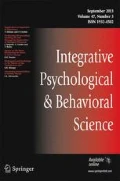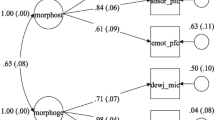Abstract
This paper presents a qualitative observational study aimed at exploring microtransitions in the relational dynamics of family functioning when the children are adolescents. Three concurrent levels were considered central for family functioning in this period: the acknowledgment of emerging competences, the redefinition of the power structure, and the regulation of interpersonal distances. Twenty-eight non-clinical Italian families with at least one adolescent child were interviewed and video-recorded in their homes. A stance-taking process analysis was carried out on the family interactive sequences arising in the course of the interviews. This analysis was based on the stances taken by all family members in relation to their reciprocal evaluations, positions, and alignments, which allowed us to point out the interlocking of competences, power and distances. Out of all the possible theoretical combinations of these three dimensions, we identified four forms of interaction. In two forms, the emerging changes were not incorporated in the families’ interactive repertoires by either reconfirming family stability or resisting family changes. In these ways of interacting competences, power, and distances were not reorganized. In the other two forms, instead, family microtransitions were observable in the extent to which family members either explored family changes or legitimated family reorganizations. In these processes, they could redefine and readdress their ways of interacting.
Similar content being viewed by others
Notes
The technique was partly borrowed from the circular interviewing developed for systemic family therapy (Selvini Palazzoli et al. 1980).
References
Arcidiacono, F., & Pontecorvo, C. (2009). Cultural practices in Italian family conversations: verbal conflict between parents and preadolescents. European Journal of Psychology of Education, 24, 97–117.
Aronsson, K., & Cekaite, A. (2011). Activity contracts and directives in everyday family politics. Discourse & Society, 2, 1–18.
Baril, M. E., Crouter, A. C., & McHale, S. M. (2007). Processes linking adolescent well-being, marital love, and coparenting. Journal of Family Psychology, 21, 645–654.
Beyers, W., & Grossens, L. (2008). Dynamics of perceived parenting and identity formation in late adolescence. Journal of Adolescence, 31, 165–184.
Breunlin, D. (1988). Oscillation theory and family development. In C. J. Falicov (Ed.), Family transitions. Continuity and change over the life cycle (pp. 133–158). New York: The Guilford Press.
Claes, M., Perchec, C., Miranda, D., Benoit, A., Bariaud, F., Lanz, M., et al. (2011). Adolescents’ Perceptions of parental practices: a cross-national comparison of Canada, France, and Italy. Journal of Adolescence, 34, 225–238.
Collins, W. A., & Laursen, B. (2004). Parent-adolescent relationships and influences. In R. M. Lerner & L. Steinberg (Eds.), Handbook of adolescent psychology (2nd ed., pp. 331–361). Hoboken: Wiley.
Cowan, P. A. (1991). Individual and family life transitions: a proposal for a new definition. In P. A. Cowan & M. Hetherington (Eds.), Family transitions (pp. 3–30). Hillsdale: Lawrence Erlbaum.
Du Bois, J. W. (2007). The stance triangle. In R. Englebretson (Ed.), Stancetaking in discourse. Subjectivity, evaluation, interaction (pp. 140–182). Amsterdam/Philadelphia: John Benjamins.
Everri, M. (2011). Le microtransizioni nelle famiglie con figli adolescenti. Un gioco di equilibri. Giornale Italiano di Psicologia dello Sviluppo, 99, 91–99.
Furlong, A. (Ed.). (2009). Handbook of youth and young adulthood. London: Routledge.
Grotevant, H. D., & Cooper, C. R. (1985). Patterns of interaction in family relationships and the development of identity exploration in adolescence. Child Development, 56, 415–428.
Grych, J. H., Raynor, S. R., & Fosco, G. M. (2004). Family processes that shape the impact of interparental conflict on adolescents. Development and Psychopathology, 16, 649–665.
Harré, R., & van Langenhove, L. (1999). Introducing positioning theory. In R. Harré & L. van Langenhove (Eds.), Positioning theory (pp. 14–31). Oxford: Blackwood.
Hartup, W. W., & Laursen, B. (1991). Relationships as developmental contexts. In R. Cohen & A. W. Siegel (Eds.), Context and development (pp. 253–279). Hillsdale: Erlbaum.
Henry, C. S., Sager, D. W., & Plunkett, S. W. (1996). Adolescents’ perceptions of family system characteristics, parent-adolescent dyadic behaviors, adolescent qualities, and adolescent empathy. Family Relations, 45, 283–292.
Holmbeck, N. G. (1996). A model of family relational transformations during the transition to adolescence: parent-adolescent conflict and adaptation. In J. A. Graber, J. Brooks-Gunn, & A. C. Petersen (Eds.), Transitions through adolescence. Interpersonal domains and context (pp. 36–65). Mahwah: Erlbaum.
Kerig, P. K., & Lindahl, K. M. (2001). Family observational coding system: Resources for systemic research. Mahwah: Lawrence Erlbaum.
Kreppner, K. (2002). Retrospect and prospect in the psychological study of families as systems. In J. P. McHale & W. S. Groenick (Eds.), Retrospect and prospect in the psychological study of families (pp. 164–186). Hillsdale: Lawrence Erlbaum.
Kreppner, K. (2005). Family assessment and methodological issues. European Journal of Psychological Assessment, 4, 249–254.
Minuchin, S. (1974). Families and family therapy. Cambridge: Harvard University Press.
Molinari, L., Everri, M., & Fruggeri, L. (2010). Family micro-transitions: observing the process of change in families with adolescent children. Family Process, 49, 236–250.
Ochs, E., & Taylor, C. (1996). “The father knows best dynamic” in family dinner narratives. In K. Hall (Ed.), Gender articulated: Language and the socially constructed self (pp. 99–122). London: Routledge.
Olson, D. H. (2000). Circumplex model of marital and family systems. Journal of Family Therapy, 22, 144–167.
Reiss, D. (1981). The family’s construction of reality. Cambridge: Harvard University Press.
Sabatelli, R. M., & Anderson, S. A. (1991). Family dynamics, peer relationships, and adolescents’ psychological adjustment. Family Relations, 40, 363–369.
Sameroff, A. J., & Seifer, R. (1983). Familial risk and child competence. Child Development, 54, 1254–1268.
Schegloff, E. A. (2007). A primer in conversation analysis. Cambridge: Cambridge University Press.
Selvini Palazzoli, M., Boscolo, L., Cecchin, G., & Prata, G. (1980). Hypothesizing, circularity, neutrality: three guidelines for the conductor of the session. Family Process, 19, 3–12.
Shapiro, E. R. (1988). Individual change and family development: individuation as a family process. In C. J. Falicov (Ed.), Family transitions. Continuity and change over the life cycle (pp. 159–180). New York: The Guilford Press.
Smetana, J. (Ed.) (2005). Changing boundaries of parental authority during adolescence. New Directions for Child and Adolescent Development, n. 108.
Sprenkle, D. H., & Piercy, F. P. (2005). Research methods in family therapy. New York: The Guilford Press.
Stattin, H., Persson, S., Burk, W., & Kerr, M. (2011). Adolescents’ perceptions of the democratic functioning in their families. European Psychologist, 16, 32–42.
Streeck, J., Goodwin, C., & Le Baron, C. (Eds.). (2011). Embodied interactions. Language and body in the material world. New York: Cambridge University Press.
Author information
Authors and Affiliations
Corresponding author
Rights and permissions
About this article
Cite this article
Everri, M., Fruggeri, L. & Molinari, L. Microtransitions and the Dynamics of Family Functioning. Integr. psych. behav. 48, 61–78 (2014). https://doi.org/10.1007/s12124-013-9248-9
Published:
Issue Date:
DOI: https://doi.org/10.1007/s12124-013-9248-9




